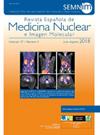彻底改变前列腺癌的治疗:现代治疗方法中的前列腺特异性抗原治疗
IF 1.6
4区 医学
Q3 RADIOLOGY, NUCLEAR MEDICINE & MEDICAL IMAGING
Revista Espanola De Medicina Nuclear E Imagen Molecular
Pub Date : 2025-05-13
DOI:10.1016/j.remn.2025.500162
引用次数: 0
摘要
前列腺特异性膜抗原(PSMA)靶向放射性核素治疗重塑了转移性去势抵抗性前列腺癌(mCRPC)的治疗前景,提供了超越传统方法的新治疗可能性。其中最有希望的策略是luteium -177 PSMA-617,在几项临床试验中显示出在总生存期和持久PSA反应方面的显着益处。与此同时,新型放射性核素(如锕-225)的开发为更有效的治疗打开了大门,能够克服先前的耐药性,特别是对先前暴露于β排放物的患者。PSMA PET成像的使用和预测性生物标志物的识别有助于改进患者选择,有助于更个性化的方法。与卡巴他赛等药物的比较研究进一步支持了该策略的安全性和有效性。本文概述了psma靶向放射性核素治疗的临床进展,研究了新兴的联合治疗方法,回顾了α释放剂的发展,并强调了个性化剂量测定在临床实践中的作用,强调了这种治疗方式在前列腺癌不同阶段的重要性。本文章由计算机程序翻译,如有差异,请以英文原文为准。
Revolucionando el tratamiento del cáncer de próstata: la terapia dirigida al antígeno prostático específico en el enfoque moderno terapéutico
Prostate-specific membrane antigen (PSMA)-targeted radionuclide therapy has reshaped the treatment landscape for metastatic castration-resistant prostate cancer (mCRPC), offering new therapeutic possibilities beyond conventional approaches. Among the most promising strategies is lutetium-177 PSMA-617, which has shown significant benefits in overall survival and durable PSA responses, as demonstrated in several clinical trials.
At the same time, the development of novel radionuclides such as actinium-225 has opened the door to more potent treatments capable of overcoming prior resistance, particularly in patients previously exposed to beta emitters. The use of PSMA PET imaging and the identification of predictive biomarkers have helped refine patient selection, contributing to a more personalized approach. Comparative studies with agents like cabazitaxel have further supported the safety and effectiveness of this strategy.
This article provides a critical overview of clinical advances in PSMA-targeted radionuclide therapy, examines emerging combination treatments, reviews the development of alpha-emitting agents, and highlights the role of personalized dosimetry in clinical practice, underlining the growing importance of this therapeutic modality across different stages of prostate cancer.
求助全文
通过发布文献求助,成功后即可免费获取论文全文。
去求助
来源期刊

Revista Espanola De Medicina Nuclear E Imagen Molecular
RADIOLOGY, NUCLEAR MEDICINE & MEDICAL IMAGING-
CiteScore
1.10
自引率
16.70%
发文量
85
审稿时长
24 days
期刊介绍:
The Revista Española de Medicina Nuclear e Imagen Molecular (Spanish Journal of Nuclear Medicine and Molecular Imaging), was founded in 1982, and is the official journal of the Spanish Society of Nuclear Medicine and Molecular Imaging, which has more than 700 members.
The Journal, which publishes 6 regular issues per year, has the promotion of research and continuing education in all fields of Nuclear Medicine as its main aim. For this, its principal sections are Originals, Clinical Notes, Images of Interest, and Special Collaboration articles.
 求助内容:
求助内容: 应助结果提醒方式:
应助结果提醒方式:


